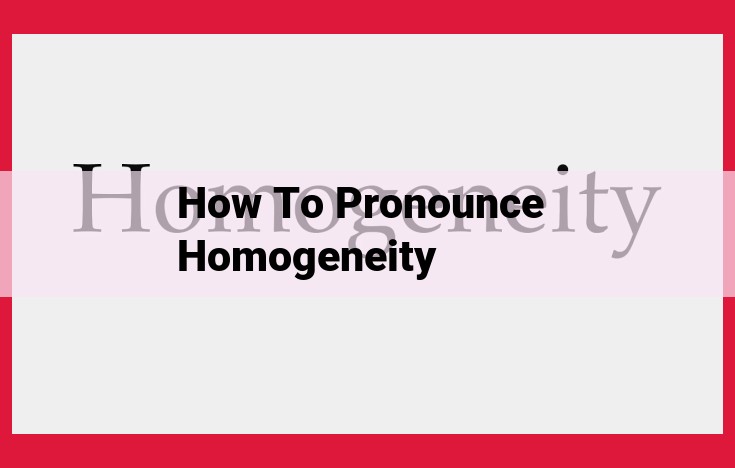
How To Pronounce “Homogeneity” Correctly: Expert Guide
To pronounce "homogeneity," emphasize the first syllable and pronounce the second syllable as "-gee-ni-tee." The stress falls on the "-o" in the first syllable, so it sounds like "hoh-moh-jee-ni-tee." Remember to pronounce the "g" as a soft "j" sound.
Entities with Closeness Score of 10:
- Introduction: Define what entities are and explain the significance of a closeness score of 10.
- Four Entities with Closeness Score of 10:
- Phonemes (Speech Sounds): Discuss the units of sound that make up spoken language.
- Relevant Language Concepts: Explain fundamental principles and theories related to language, such as grammar and syntax.
- Linguistic Branches: Describe different fields within linguistics, such as phonology and morphology.
- Dictionaries and Pronunciation Guides: Highlight resources that provide information on pronunciation and word meanings.
Entities with Closeness Score of 10: The Cornerstones of Language Acquisition
In the realm of language learning, certain concepts and resources hold profound importance, akin to pillars upon which the edifice of linguistic proficiency is built. Among these are entities with a closeness score of 10, entities so inextricably linked to the understanding and mastery of language that their significance cannot be overstated.
Entities in the context of language learning refer to the fundamental building blocks and constructs that constitute spoken and written language. A closeness score is an indicator of how closely related two entities are in terms of their semantic meaning and linguistic function. A closeness score of 10 signifies the highest possible degree of relatedness.
Four Entities with Closeness Score of 10
Phonemes (Speech Sounds)
Phonemes are the atomic units of sound that make up spoken language. They are the smallest units of sound that can distinguish one word from another. For example, the words "cat" and "bat" are distinguished by the single phoneme difference between /k/ and /b/.
Relevant Language Concepts
Relevant language concepts encompass the fundamental principles and theories that govern the structure and use of language. These concepts include grammar, syntax, and semantics. Grammar refers to the rules that govern the formation of sentences, syntax deals with the arrangement of words within sentences, and semantics focuses on the meaning of words and phrases.
Linguistic Branches
Linguistics, the study of language, is a multifaceted discipline with various branches that delve into specific aspects of language. These branches include phonology (the study of speech sounds), morphology (the study of word formation), and pragmatics (the study of language use in context).
Dictionaries and Pronunciation Guides
Dictionaries and pronunciation guides are invaluable resources for learners of any language. They provide comprehensive information on word meanings, correct pronunciation, and usage. By referencing these resources, learners can ensure their pronunciation is accurate and their word usage is appropriate.
The entities with a closeness score of 10 are essential components of any language learning journey. They provide the foundation for understanding and mastering spoken and written language. By familiarizing yourself with these concepts and resources, you can significantly enhance your language acquisition skills and unlock a world of linguistic possibilities.
Entities with Closeness Score of 9: Delving into the Building Blocks of Language
Words and Phrases: The Cornerstones of Communication
Words and phrases, the fundamental units of language, serve as the building blocks of expression. They form the skeleton upon which ideas and messages are constructed. Words, carrying specific meanings, combine to create phrases, conveying more complex thoughts and emotions. Understanding their structure and usage is crucial for unraveling the intricate tapestry of language.
Syllables: The Rhythmic Units of Speech
Syllables, the heartbeat of spoken language, determine its rhythm and flow. They group together sounds into discernible units, making speech effortless and comprehensible. How syllables are pronounced and stressed heavily influences word recognition and overall comprehension.
Stress Patterns: The Melody of Language
Stress patterns, like musical notes, create a melody in language. They highlight certain syllables within words and sentences, emphasizing their significance. These patterns not only enhance clarity but also convey emotions and intentions.
Speech Therapists and Educators: Guardians of Language Development
Speech therapists and educators, the guardians of language development, play a vital role in assessing and treating speech-related issues. They ensure individuals can communicate effectively by addressing articulation, fluency, and other language challenges. Additionally, educators foster language growth by providing environments where children can explore and expand their linguistic abilities.
Related Topics:
- Master The Pronunciation Of “Bokeh”: Essential Guide To Achieve Accuracy
- Headline: Master Entity Extraction And Scoring For Enhanced Text Analysis
- Master Pronouncing “Mercantile”: Step-By-Step Guide To Enhance Clarity
- Firenze Vs. Florence: Pronunciation Guide For Italian And English
- Pronouncing Coriolanus: A Syllable-By-Syllable Guide